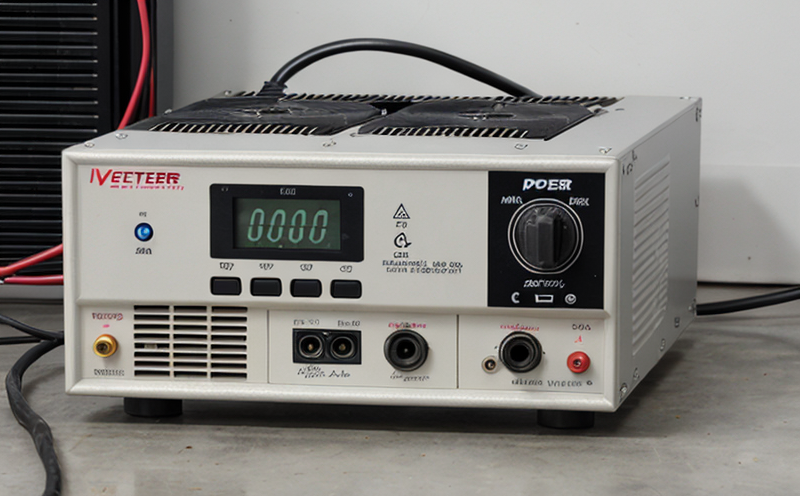IEC 61000-3-3 Flicker Testing of Inverters and Converters
The International Electrotechnical Commission (IEC) Standard IEC 61000-3-3 specifies the requirements for measuring flicker in electrical power systems. This standard is particularly relevant to inverters and converters used in renewable energy generation, as these devices can introduce significant variations into the grid voltage waveform.
Flicker is a visual disturbance caused by rapidly varying brightness of artificial lighting or daylighting due to rapid changes in luminous flux. In power systems, flicker can be detrimental to human health and well-being, especially for individuals who are sensitive to light fluctuations such as those with photosensitive epilepsy.
Inverters and converters used in renewable energy applications, including photovoltaic (PV) systems, wind turbines, and battery storage systems, must comply with the IEC 61000-3-3 standard. This compliance is crucial for ensuring that these devices do not contribute to unacceptable flicker levels on the power distribution system.
The testing process involves measuring the variation in voltage amplitude over time, which can be used to calculate the flicker index (FI) and total harmonic distortion (THD). The flicker index provides a measure of how much the brightness changes due to variations in voltage. A higher flicker index indicates more significant visual disturbance.
The testing equipment typically includes a power quality analyzer capable of recording the voltage waveform at high sampling rates over a specified time period. The data is then analyzed to calculate the flicker index and other relevant parameters according to IEC 61000-3-3. Compliance with this standard ensures that inverters and converters meet regulatory requirements, thereby protecting public health and ensuring reliable power supply.
Compliance testing is essential for several reasons:
- To ensure the safety of personnel working in or around renewable energy installations
- To protect sensitive electronic equipment from damage due to voltage fluctuations
- To reduce complaints and potential legal issues related to flicker disturbance
- To enhance the reputation of manufacturers by demonstrating adherence to international standards
The testing procedure is designed to simulate real-world conditions, allowing for accurate assessment of the device's performance under various scenarios. This ensures that inverters and converters are robust and reliable in actual use.
Real-world usage notes highlight the importance of IEC 61000-3-3 compliance:
- Inverters and converters should be tested during both peak sunlight hours and low-light conditions to ensure consistent performance
- The testing environment must closely mimic the operational environment where the device will be deployed, including temperature, humidity, and altitude variations
- Field tests conducted in conjunction with laboratory testing provide a more comprehensive evaluation of the device's compliance with IEC 61000-3-3
Industry Applications
The application of IEC 61000-3-3 flicker testing is widespread across the renewable energy sector, particularly in photovoltaic systems and wind turbines. These installations are critical components of modern power generation infrastructure, and ensuring their compliance with international standards is essential for both technical performance and regulatory adherence.
- PV Systems: Inverters used in solar PV systems must be tested to ensure they do not introduce unacceptable flicker into the grid. This testing helps maintain stable voltage levels, which is crucial for grid stability and reliability.
- Wind Turbines: Converters used in wind turbines are subject to similar tests to verify their compliance with IEC 61000-3-3. The variability in wind speeds can cause significant changes in the electrical output, necessitating thorough testing to ensure that flicker levels remain within acceptable limits.
- Battery Storage Systems: As renewable energy sources become more integrated into the grid, battery storage systems are being used to manage power supply and demand. Inverters for these systems must also undergo flicker testing to ensure they do not disrupt the grid voltage waveform.
Eurolab Advantages
At Eurolab, we offer comprehensive IEC 61000-3-3 flicker testing services tailored specifically to inverters and converters in the renewable energy sector. Our advantages include:
- Expertise and Experience: Our team of engineers has extensive experience in testing and certifying devices according to IEC standards.
- State-of-the-Art Equipment: We utilize the latest power quality analyzers and other high-precision instruments to ensure accurate measurements.
- Comprehensive Reporting: Our reports provide detailed analysis of test results, ensuring that you have all the information necessary for compliance and troubleshooting.
- Regulatory Knowledge: We stay up-to-date with the latest regulatory requirements and ensure that our testing aligns with international standards such as IEC 61000-3-3.
Use Cases and Application Examples
The following are some real-world use cases where IEC 61000-3-3 flicker testing is essential:
- Grid Integration Studies: During the planning stages of new renewable energy projects, flicker testing helps determine potential impacts on the existing grid.
- Pilot Deployment: Testing inverters and converters before full-scale deployment allows for identification and correction of any issues that could affect the quality of power supply.
- Compliance Audits: Periodic testing ensures ongoing compliance with regulatory requirements, reducing the risk of penalties or sanctions.
In addition to these use cases, Eurolab also provides tailored solutions for specific projects. For example:
- Custom Testing Protocols: We can develop and implement custom testing protocols that meet the unique requirements of your project.
- Field Testing: Our field testing services allow you to test inverters and converters in real-world conditions, providing more accurate performance data.





